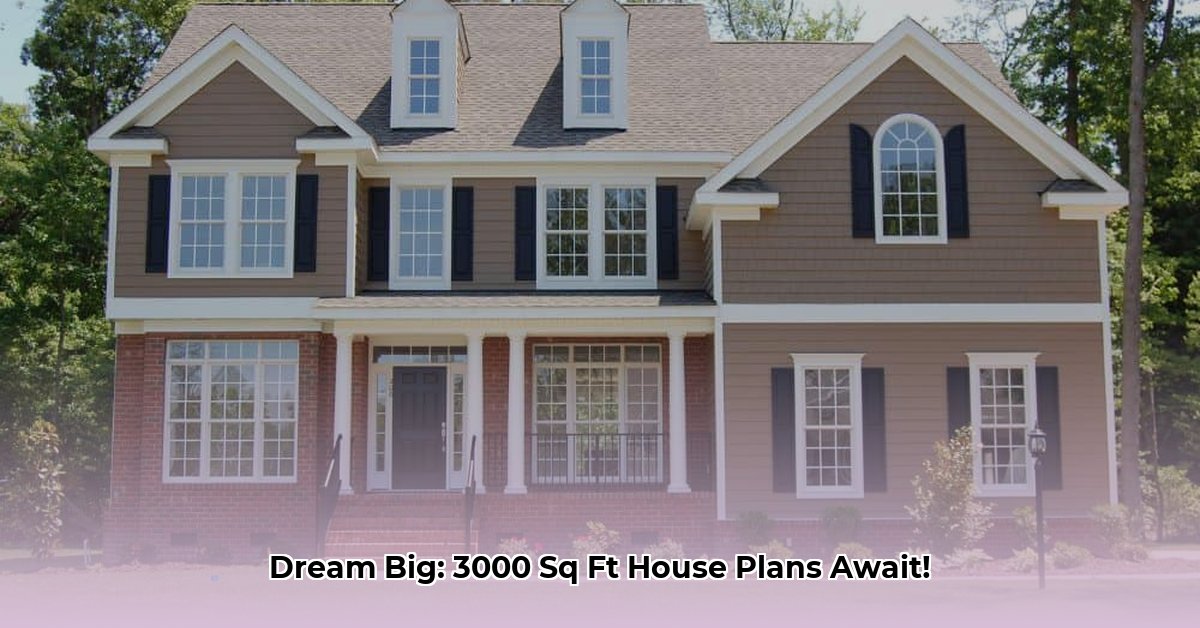Thinking about a house with ample space? A 3,000 square foot home offers a wealth of possibilities, from large family gatherings and a chef’s kitchen to a relaxing master suite and a dedicated home office. This comprehensive guide explores everything you need to know about designing your ideal space, from architectural styles and layouts to cost considerations and construction. Get ready to build the home you’ve always wanted!
Right-Sizing Your Dream: Is 3000 Square Feet Right for You?
A 3,000 square foot house presents exciting opportunities. It can comfortably accommodate a growing family, dedicated hobby spaces, or a home office. But before diving into blueprints, consider if this size truly aligns with your lifestyle and needs. Like finding the perfect pair of shoes – style is important, but comfort and practicality are key. A 3,000 square foot home can be an excellent choice, but ensure it’s the “just right” fit.
Planning Your Space: Understanding 3000 Square Foot House Plans
House plans are the blueprint of your future home, dictating flow, functionality, and how you’ll live in it. A 3,000 square foot home allows for distinct zones: a spacious kitchen flowing into a family room, a separate master suite, a dedicated home office, a playroom, or a media room. Careful planning tailors the floor plan to your unique lifestyle.
Defining Your Style: Exploring Architectural Options
From classic to contemporary, a 3,000 square foot house can embrace various architectural styles. A sprawling ranch, a charming Craftsman, a modern farmhouse, a traditional home with a grand entrance, or a sleek minimalist exterior – the options are diverse. Choose a style that complements the size and resonates with your personal taste.
| Style | Characteristics | Potential Considerations |
|---|---|---|
| Ranch | Single-story living, open floor plans, often L-shaped or U-shaped | May require a larger lot, potential for less privacy between rooms |
| Craftsman | Handcrafted details, built-in features, covered porches, fireplaces | Can be more expensive to build, may require more maintenance |
| Modern Farmhouse | Rustic aesthetic, metal accents, open concept living, high ceilings | Trend’s longevity is uncertain, material costs can fluctuate |
| Colonial | Symmetrical design, grand entrance, formal living spaces | May be less energy-efficient, can feel formal |
| Contemporary | Clean lines, large windows, open floor plans, minimalist décor | May require specialized materials and builders, suitability for all climates is uncertain |
Building Your Vision: The Construction Process
Building a home can feel daunting, but breaking it down into manageable steps simplifies the process. Start with a clear vision, create a timeline, and assemble a reliable team. Securing land, selecting a reputable builder, and choosing the right house plan are crucial first steps. Open communication with your builder and architect ensures a smooth build.
Budgeting Smartly: Estimating Costs
Building a 3,000 square foot home is a significant investment. Factors like location, materials, and labor influence the final cost. Metropolitan areas are likely more expensive than rural settings, and premium finishes cost more than standard options. Working with a financial advisor and obtaining multiple bids from builders helps create a realistic budget.
Maximizing Space: Smart Planning Strategies
Smart space planning is essential, even in a spacious 3,000 square foot home. Built-in storage, multi-functional furniture, open-concept layouts, and strategically placed windows maximize functionality, create a comfortable living environment, and enhance the overall ambiance.
Building Green: Sustainable Design Choices
Sustainable living is a responsible choice. Eco-friendly features benefit the environment and your wallet. Solar panels, energy-efficient appliances, and sustainable building materials like reclaimed wood or bamboo may have higher initial costs, but long-term savings and reduced environmental impact make them worthwhile.
Multigenerational Living: Designing for Extended Family
A 3,000 square foot house accommodates multigenerational living. Separate living quarters with private entrances allow for togetherness and independence. Universal design principles, like wider doorways and accessible bathrooms, enhance comfort for all ages and abilities.
Smart Home Integration: Enhancing Convenience and Security
Integrating smart home technology enhances convenience, security, and energy efficiency. Smart thermostats, lighting systems, and security systems offer personalized control and automation.
Deep Dive into Design: Exploring 3000 Square Foot House Plans
A 3,000 square foot house plan offers a blank canvas. It’s not just about square footage, but how the space works for you. This involves considering layout, room count, and how these elements create a functional and comfortable home.
Visualizing the Layout: Dimensions and Lot Placement
Consider the footprint of a 3,000 square foot house. Is it a sprawling ranch or a multi-story Craftsman? Dimensions impact how the house sits on the property. The plan becomes a roadmap, showing the shape and flow of your future home – how you’ll move through it daily. A well-designed plan optimizes this flow.
Rooms and Functionality: Adapting to Your Needs
With 3,000 square feet, you have choices. Five bedrooms or three bedrooms and a home office? A guest suite? Multiple bathrooms? A home office, playroom, gym, or media room? Tailor the design to your lifestyle and adapt to future needs.
Style and Function: Balancing Aesthetics and Practicality
Architectural style influences layout and functionality. A modern farmhouse may have an open-concept design, while a Craftsman home might have separate spaces. Your style – minimalist, traditional, airy, cozy – shapes the home’s atmosphere.
Budgeting for Your Build: Navigating Construction Costs
Building a home of this size requires financial planning. Material costs, labor, permits, and inspections contribute to the final price. Research average building costs and compare house plans for a realistic budget. A well-built home often holds its value over time.
Lifestyle and Layout: Planning for the Future
Choose a plan that supports your current and future lifestyle. A family with young children might prioritize a playroom near the living area, while empty-nesters might prefer a guest suite. A flexible layout that adapts to evolving needs is a valuable asset.
| Feature | Considerations |
|---|---|
| Size | Ample space for layouts accommodating diverse needs and features. |
| Layout | Room arrangement, flow, dimensions—crucial for lot placement and daily living. |
| Rooms | Bedroom/bathroom count, specialized spaces, guest accommodations. |
| Style | Architectural choices influence design, functionality, and overall aesthetic. |
| Cost | Plan acquisition and construction expenses; research and budgeting are essential. |
| Lifestyle Fit | Matching layout and features to current and future needs creates a personalized home. |
Careful consideration of these aspects helps you choose a design that truly reflects your vision.
Choosing Your Plan: Layout, Style, and Features
Picking the right 3,000 square foot house plan involves considering layouts, styles, and features that create a space reflecting your family’s needs and lifestyle.
Flow and Functionality: Layout Options
The layout is the foundation of your home’s functionality. An open-concept design seamlessly blends kitchen, dining, and living areas, ideal for hosting. A traditional layout offers distinct rooms for privacy. A multi-generational home might prioritize separate entrances and living areas.
Expressing Your Style: Architectural Choices
Architectural style is your home’s personality. Craftsman, contemporary, farmhouse, Mediterranean, ranch, colonial – each style evokes a different feeling. Consider the surrounding landscape and your personal preferences.
Enhancing Your Home: Key Features
Features personalize your home. A gourmet kitchen, luxurious master suite, cozy fireplace, home theater, gym, sunroom – these details enhance your lifestyle. Mudrooms, walk-in pantries, and outdoor kitchens are increasingly popular.
Comparing Plans: A Side-by-Side View
A comparison table helps you evaluate different house plans. Compare bedrooms, bathrooms, garage size, features, and estimated costs. This allows you to prioritize what matters most.
| Feature | Plan A | Plan B | Plan C |
|---|---|---|---|
| Bedrooms | 4 | 5 | 4 |
| Bathrooms | 3.5 | 4 | 3 |
| Garage | 3-car | 2-car | 2-car |
| Special Features | Covered porch, fireplace | Media room, home office | In-law suite, outdoor kitchen |
| Estimated Cost | $$$ | $$$$ | $$$$ |
Future-Proofing Your Home: Adaptability and Technology
Consider future needs when choosing a plan. Flexible spaces can adapt to changing lifestyles. A guest room can become a home office, or a bonus room can be divided. Consider multi-generational living and smart home technology integration.
Choosing the right plan involves understanding your needs, exploring your style, and envisioning your future life in your new home.
Visualizing Your Dream: Photos and Floor Plans
Visual aids like photos and floor plans bring your dream home to life. They are crucial for planning and visualizing your 3,000 square foot space, from open-plan living areas to dedicated workspaces and luxurious master suites.
Exploring different architectural styles – modern, Craftsman, Modern Farmhouse, Ranch – through photos helps you discover what feels right. Floor plans dictate the flow, privacy, and functionality of your home, answering questions about sunlight and movement between spaces.
Practical considerations include budget, land availability, and customization options. Research construction costs, lot size, and topography. Most house plans offer customization, allowing you to personalize the layout and features.
| Style | Features | Might be Ideal For |
|---|---|---|
| Modern Farmhouse | Open layouts, shiplap, metal accents | Families, those who love to entertain |
| Craftsman | Intricate woodwork, built-ins, cozy fireplaces | Those seeking classic charm |
| Ranch | Single-story living, sprawling layouts | Accessibility, easy maintenance |
| Contemporary | Clean lines, geometric shapes, large windows | Modern aesthetics |
Architectural styles are fluid. Homeowners often blend elements to create unique designs. Visualization and planning unlock your dream home’s potential.
Building Your 3000 Square Foot Home: Costs, Considerations, and Process
Building a 3,000 square foot home involves understanding layouts, costs, and the construction process. Let’s delve into the details of making your dream a reality.
Layout Possibilities: Single-Story, Two-Story, and Split-Level
-
Single-Story Living: Offers easy accessibility and seamless flow, ideal for families with young children or those planning for aging in place.
-
Two-Story Elegance: Maximizes footprint on smaller lots, providing privacy upstairs and grand entertaining spaces downstairs.
-
Dynamic Split-Level Homes: Creates distinct zones with short staircases connecting different levels, suitable for sloped lots.
Managing Your Budget: Estimated Cost Breakdown
Building a home requires careful financial planning. Here’s a typical budget breakdown, but actual costs can vary:
| Item | Estimated Cost Range | Considerations |
|---|---|---|
| Land | $5,000 – $200,000+ | Location significantly impacts land prices. Due diligence is crucial. |
| Site Work | Highly Variable | Soil testing, excavation, grading, and permits can be underestimated. |
| Foundation | $12,000 – $35,000+ | Foundation type and soil conditions affect costs. |
| Framing | $25,000 – $55,000+ | Lumber prices and design complexity influence costs. |
| Roofing | $10,000 – $20,000+ | Roofing material and roofline complexity affect costs. |
| HVAC, Electrical, Plumbing | $25,000 – $60,000+ | Obtain multiple bids and consider energy-efficient options. |
| Appliances | $7,000 – $25,000+ | Budget varies depending on brand, features, and quantity. |
| Interior Finishes | $40,000 – $400,000+ | Finishes represent a substantial portion of the budget. |
| Permits & Inspections | Variable, potentially several thousand dollars | Research local requirements and factor in these costs. |
The Construction Process: From Start to Finish
-
Pre-Construction: Secure financing, finalize plans, and obtain permits.
-
Foundation: Proper grading and drainage are essential for a solid foundation.
-
Framing: Walls and rooflines define the structure’s form.
-
Exterior Finishes: Roofing, siding, windows, and doors provide weatherproofing.
-
Interior Finishes: Plumbing, electrical, HVAC, insulation, drywall, paint, flooring, and fixtures are installed.
-
Final Inspections and Walkthroughs: Ensure compliance and identify any necessary adjustments.
Building a home is a journey. Partnering with experienced professionals, staying organized, and maintaining open communication ensures a smooth process. Explore cost-effective options like prefabricated components or modular construction, which may shorten the timeline and offer cost advantages. Stay informed about the latest innovations and trends in construction.
- Dora the Explorer Wipe-Off Fun: Safe & Mess-Free Activities for Little Explorers - April 18, 2025
- Does Lemongrass Repel Mosquitoes? Fact vs. Fiction + How to Use It - April 18, 2025
- Do Woodchucks Climb Trees?Fact vs. Fiction - April 18, 2025










